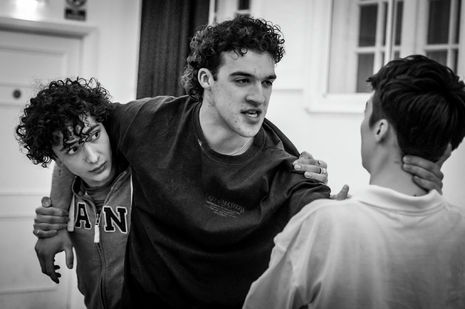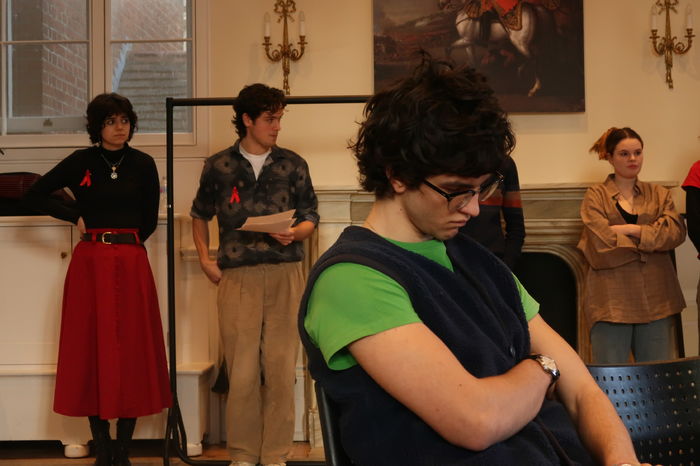The Marlowe Society’s Romeo and Juliet
The Marlowe Society’s latest Shakespeare production is at times beautiful, and at times slightly unconvincing

There is a level of trepidation attached to staging any Shakespeare play due to the looming threat of that frightening description: overdone. With hundreds of years of rich production history, it’s hard to believe that every ounce of originality hasn’t already been squeezed from the script. Yet, if I had to choose one word to describe the Marlowe Arts production of Romeo and Juliet, it would paradoxically be ‘unique’.
Director Josh Seymour chose to give the play a distinct matriarchal take. Right from the beginning, he emphasises the conflict between the two houses through the dynamic between Imogen Gray’s Lady Capulet and Alessandra Rey’s Lady Montague. This was a commendable and original choice, but fell slightly flat as a result of the notable lack of scenes in which Lady Montague’s character in particular is present, perhaps not exploring this angle to its full potential. This promising matriarchal theme came to a head in the final scene, where both mothers symbolically exchange their coloured robes to cover the bodies of their dead children.
“If I had to choose one word to describe the Marlowe Arts production of Romeo and Juliet, it would paradoxically be ‘unique’”
The use of physical theatre was also significant throughout this production, and created some of the most visually exciting moments in the play. During one of Mercutio’s monologues there was a wonderful sequence in which the stage was washed with white light, and like a puppet-master he masterfully controlled the bodies of the other characters. The physical theatre worked very well with the stark nature of the set - two large white drapes and a group of wooden brown chairs comprised all the stage decoration. Throughout the first act, characters smoothly whisked away the chairs to create a dance circle, and also Juliet’s balcony, which was creatively designed by stacking the chairs in a ring around her. This made the change in set in the second act, with the broken and intertwined chairs suspended from the ceiling like elaborate torture devices, all the more appealling.
Blending modern and classic references is often a risky move - one that slightly missed the mark in this production. When the play opened on Lady Montague and Lady Capulet dressed in corporate clothing and Romeo in a hoodie, I expected an entire reinterpretation. Instead, the majority of the dialogue stayed the same, until a sudden flurry of “fuck you”s invaded the theatre, causing confusion as to the play’s intended direction. Whilst both Romeo and Juliet felt like they were plucked straight from the Elizabethan era (despite the somewhat inexplicable decision to have Juliet in joggers for the entirety of the second act), suddenly we saw Petra (Peter) holding Primark shopping bags and Starbucks cups. I fear the Swifties amongst our readers won’t appreciate this statement, but the use of Taylor Swift’s Lover in the dancing scene felt slightly unnecessary. Furthermore, the use of ‘Love in the First Degree’ when the Nurse and Lady Capulet discovered Juliet’s body was slightly distracting and inappropriate.
“Blending modern and classic references is often a risky move - one that slightly missed the mark in this production”
Kitty Ford’s Romeo provided all the youthful energy the character requires, and their performance gave the audience a classic portrayal of the lover. Yet, throughout the show, I found myself wondering: Juliet, Juliet, wherefore art thou Juliet? The stereotype of the naive lover never has the most character depth, and I felt that Sarah Mulgrew’s Juliet had the potential to explore the character more deeply. The infamous balcony scene suffered questionable intonation, causing some of the most iconic lines of the play to feel just slightly off.
However, these imperfections fell to the wayside as we saw some stellar performances from both Jacob Benhayoun’s Mercutio and Lizzy Riley’s Nurse. Mercutio was played with the perfect blend of cheekiness and intense masculine energy, providing both lighter moments, especially in regard to the chemistry with Kiko Gomersall’s Benvolio, as well as what I found to be the most intense scene of the play: the dramatic fight with Tybalt. Credit goes to the fight director Chi-San Howard who innovatively used the motif of using coloured powder representing each house (blue for Capulet, red for Montague) to depict a sword fight, creating incredible visual play on the stage. My breath hitched as the blue powder pierced the chest of Mercutio, signifying his death. The tension was perfectly ramped up by the booming exclamation, “a plague on both your houses!” and this is where the production peaked.
“The tension was perfectly ramped up by the booming exclamation, “a plague on both your houses!” and this is where the production peaked”
Likewise Lizzy Riley’s Nurse stole the show from her first appearance. Her captivating monologue in which she seamlessly varied her accent and physicality was reminiscent of a stand-up comedian, and provided the audience with many laugh out loud moments. Whilst several times she was able to be the comedic relief character, her support and love for Juliet was genuinely heartwarming, and we got the chance to see her skilfully balance the humour and grief her character goes through in the second act.
The production was altogether enjoyable and dynamically interesting to watch, leaving the audience with the expected sense of tragedy, despite a few hitches. Yet, the pure originality and innovation of this Marlowe Arts version of the play is something you won’t find anywhere else, making the show a very worthwhile watch.
The Marlowe Arts Show Romeo and Juliet is playing at the Cambridge Arts Theatre from the 31st January to the 3rd of February.
 News / Cambridge academics stand out in King’s 2026 Honours List2 January 2026
News / Cambridge academics stand out in King’s 2026 Honours List2 January 2026 Interviews / You don’t need to peak at Cambridge, says Robin Harding31 December 2025
Interviews / You don’t need to peak at Cambridge, says Robin Harding31 December 2025 Comment / What happened to men at Cambridge?31 December 2025
Comment / What happened to men at Cambridge?31 December 2025 News / Varsity’s biggest stories of 202531 December 2025
News / Varsity’s biggest stories of 202531 December 2025 Features / “It’s a momentary expression of rage”: reforming democracy from Cambridge4 January 2026
Features / “It’s a momentary expression of rage”: reforming democracy from Cambridge4 January 2026










